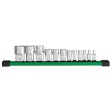
Big Joe Forklifts has unveiled new models, the 3,000-lb. (1.4 T) CB30 and 3,500-lb. (1.6 T) CB35 Walkies Counterbalance Stackers. The forklift-maker says the models are a productive and safe alternative to traditional rider forklifts, especially in cases where high speed travel is not required or where the use of rider forklifts poses a threat to pedestrians.
Big Joe chief marketing officer Bill Pedriana said: “The new CB30/35 are a fantastic alternative to traditional forklifts, and in operations a great answer to the question we often pose, which is ‘why ride when you can walk?’”
The CB30 and CB35 stackers have 4.6 in. (11.7 cm) of ground clearance, forward and back hydraulic tilt, standard electric power steering, a 180-degree steer arc and are available in two or three-stage configuration for low- or high-level handling, reaching up to a 157-in. (400 cm) lift height. The CB30/CB35 are available with lead acid or lithium batteries.
“We designed these machines to provide exceptional value and flexibility in smaller facilities as a one truck solution or to supplement traditional rider equipment in the biggest of operations,” said Pedriana.
IRONPROS Perspective
Both stackers and forklifts have a place in construction. It would be very difficult to force a stacker to do the jobs of forklifts on worksites. Forklifts have a notably higher operating capacity, reaching ranges of 20,000 and 35,000+ lbs. for rough terrain or heavy-duty models. By comparison, stackers usually max out at 4,100 lbs.
These machines excel in managing light-to-medium loads around very tight spaces. Consider that with a stacker, operators walk with the unit. There is no cab for protection, as you would find on a forklift. Using a stacker all day can lead to fatigue, compromising an operator's ability to focus and carry out critical tasks. Forklifts can help avoid this scenario and enable more consistent output with less safety risks.
In a large construction, manufacturing or warehousing operation, you could see both machines on the worksite. Forklifts would do the heavy lifting, transporting across far distances and loading. After breaking down materials or pallets to smaller, more manageable loads, a stacker would come in to make the final placement or move.
With that being said, small businesses or construction projects could be fine with using a stacker for their lifting needs. Stackers are less costly than forklifts and would serve as cost-effective solutions.
The right lifting equipment can boost productivity on the jobsite. View your options using the IRONPROS product search tool.
















